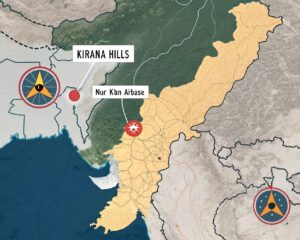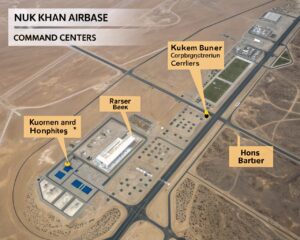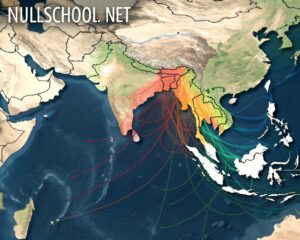India-Pakistan Conflict: Did a Nuclear Leak Trigger Global Concern?
Recent events involving India, Pakistan, and even the United States have sparked a flurry of speculation and anxiety in a time when geopolitics is changing daily. The main point? Rumours of radioactive leakage and a potentially disastrous event at Pakistan’s Nur Khan Airbase. Knowing what actually took place and the potential worldwide effects, this article looks deeply into the expanding conversation surrounding this hidden conflict.
What Sparked the Nuclear Controversy?
When a journalist asked India’s Air Marshal about a potential airstrike on Kirana Hills, which has long been suspected of housing a nuclear facility, the discussion started.

In response, India’s Air Chief Marshal was ambiguous and ironic: We appreciate you informing us that there are nuclear installations in Kirana Hills. We were unaware of it. All right. And whatever is there, we haven’t reached Kirana Hills. More curiosity was sparked by the sarcasm. American think tanks and intelligence sources began pointing in a completely different direction—Nur Khan Airbase—while India denied the strike.
The Focus Shifts: Nur Khan Airbase Under the Radar
What is Nur Khan Airbase?
Nur Khan Airbase, which is close to Islamabad and Rawalpindi, is not your typical military facility. Defence analysts claim that it is closely related to Pakistan’s nuclear command and storage facilities.

The supposed attack on Nur Khan is so important because of its strategic importance. The Indian Air Force may have accidentally or purposely damaged a nuclear storage facility, resulting in a radioactive leak, according to a number of reports, mostly from the U.S. media.
U.S. Intervention: Silent but Swift
The United States reacted swiftly and secretly after realising the seriousness of the situation. According to the New York Times
The US sent a special plane to Pakistan and gave Egypt instructions to send sand and boron, which are frequently used in nuclear containment.

This was more than a safety measure. The National Nuclear Security Administration (NNSA) deployed the Beech King Air 250, designed for emergency nuclear control. Its purpose is to stop radioactive leaks before they spread.
Tracking the Untrackable: Flight Surveillance Reveals Clues
Open-source websites for tracking flights were discovered:
U.S. aircraft landing covertly at Nur Khan Airbase
Egyptian transport aircraft landing without a mission statement
No joint military exercise included this. Reports of radiation containment efforts coincided with the timing.
India’s Ceasefire: Coincidence or Calculation?
At the same time, silence came down on media outlets. Popular non-interventionist J.D. Vance suddenly summoned Indian Prime Minister Narendra Modi with “alarming intelligence.” Across the Line of Control (LoC), Pakistan remained silent while India announced an unexpected ceasefire shortly after.
What was different?
According to the theory, Vance was given intelligence regarding the possibility of a regional nuclear accident.
Why Should the World Care?
This is not only a regional problem, even if someone takes the passive approach of “Let Pakistan deal with it!”

Global wind patterns can be tracked in real time via the website nullschool.net. Radioactive particles could drift eastward into India, Nepal, or even China if there is a nuclear leak in Pakistan. Borders are not the end of radiation.
Global Fallout: What If the Leak Was Worse?
If the situation had gotten out of hand:
Millions of people could have been impacted if radioactive material had contaminated the Indus River system.
Long-term health problems may affect those who live in Lahore, Amritsar, Delhi, and other surrounding areas.
Fears of radiation could disrupt international trade routes that pass through the area.
Conclusion: A Wake-Up Call for South Asia
Despite being mostly hidden, this situation ought to serve as a warning. Nuclear facilities are not battlefields, regardless of who is at fault. There is a huge chance of an unplanned disaster, and the damage might not be as controllable the next time.
Nur Khan Airbase’s story is still being told. The world is watching, though, and the gap between military strategy and worldwide a disaster is becoming increasingly blurry.
Frequently Asked Questions
Q1. Did India really strike a nuclear facility in Pakistan?
While not officially confirmed, multiple think tanks and flight tracking evidence suggest a high probability of such an event near Nur Khan Airbase.
Q2. What is boron used for in nuclear disasters?
Boron helps absorb neutrons and contain nuclear reactions, commonly used in radioactive leak scenarios.
Q3. Is the situation under control now?
Based on current silence across diplomatic and media channels, it seems efforts were successful in containing the leak — but long-term monitoring continues.
Q4. Could radiation affect neighboring countries?
Yes, due to wind flow, radioactive material could drift into India, China, or even further, depending on environmental conditions.
Final Thoughts
This developing story demonstrates how precarious peace is in an area with nuclear weapons. It is obvious from the silent intervention of world powers to avert disaster that geopolitical tensions in South Asia have the capacity to rock the globe.
